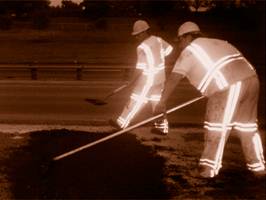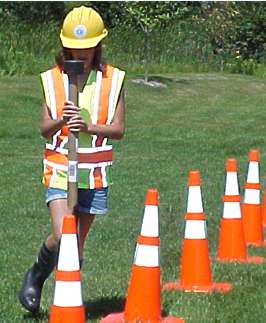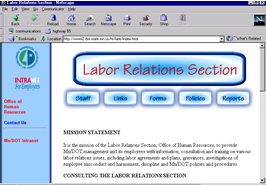 |
 |







|
 |
 |
 |
 |
 |
 |
 moving minnesota through employee communication moving minnesota through employee communication |
 |
 |
 April
4 , 2001 April
4 , 2001 |
No. 8 |
 |
|
|
 |

|
 |
Summer construction, safety season begins
|
 |
 |
 |
Look for this picture
as part of Mn/DOT's work zone safety campaign.
|
At news conferences in the Twin Cities and Rochester
this week Mn/DOT announced it will invest $849.3 million in new or continued
projects for the state’s transportation system this year.
This year’s transportation program includes 252
projects statewide, some of which support the ABCs of Mn/DOT’s Moving Minnesota
initiative: Advantages for transit, Bottleneck removal and Corridor connections.
"The 2001 construction program will not solve
all our transportation problems," said Commissioner Elwyn Tinklenberg.
"It will, however, strengthen Minnesota’s ability to move products, people
and services to support the state’s growing and increasingly diverse economy.
Our goal is to provide the people of Minnesota choices that include park and
ride lots, transit stations and bus-only shoulder lanes as well as enhancing
their commute by reducing congestion caused by bottlenecks."
Last year Mn/DOT received $459 million to fund
the ABCs. Mn/DOT will use $47 million of that amount to fund the following projects
this year:
- Advantages for transit—includes work on six
park and ride facilities in the Metro area. In addition to enhancements to
three existing sites (Burnsville, Eagan and Eden Prairie), park and ride lots
will be added in Elk River, Big Lake and Coon Rapids along Highway 10 to serve
the soon-to-be-developed Northstar Corridor busway. Metro’s existing 128-mile
bus-only shoulder lanes will add 31 miles this year. Also, four transit hubs
will be built along I-35W.
- Bottleneck removal projects—includes work to
widen portions of the roadways at Highway 100 from Golden Valley Road to Highway
81; and I-494 from Valley Creek Road to I-94. These projects will also help
reduce congestion.
- Corridor connection projects—includes work to
improve safety and traffic flow on Highway 14 in Owatonna between I-35 and
Highway 218; Highway 60 from Heron Lake to Brewster; and Highway 169 between
Zimmerman and Princeton.
Other construction projects statewide will range
from resurfacing to bridge replacements to re-building projects on the state’s
12,100-mile transportation system. Locations will vary from the most remote
sections of northern Minnesota to the most heavily traveled highways that serve
the state’s major cities.
Mn/DOT produces a "Get Around Guide"
in the spring and midsummer for travelers available from travel information
centers and Mn/DOT offices. Mn/DOT also keeps current information on its Web
site at www.dot.state.mn.us.
Closely tied to the construction kick-off is Mn/DOT’s
Work Zone Safety Awareness Program. The program’s theme, "See Orange. We’re
in the Work Zone Together," reminds workers and travelers that they share
the responsibility for safety in roadway, maintenance and construction zones.
Mn/DOT will observe Worker Memorial Day this year
on April 24. As part of the observance, the commissioner will give an address
in District 8-Granite Falls, closing with a moment of silence at 2 p.m.
For more information about this year’s construction
program see the April
4 construction program news release or
contact Judy Jacobs, 651/284-3221. For more information about the work zone
safety program, contact Mary Meinert, 651/297-5868.
|
back

|
 |
Municipal consent, design-build bills advance in Legislature
|
 |
 |
The Senate Transportation Policy Committee passed a bill April 3 that would create
a shorter, better process for resolving disputes between Mn/DOT and cities over
the design of trunk highway projects located in cities. The bill received approval
last week from the House Transportation Policy Committee.
The measure still needs approval from the full Legislature. Under the bill’s
provisions, Mn/DOT would continue to make the final decision on the design of
projects on the interstate system, while municipalities would have final approval
on all other trunk highways.
The bill retains the appeal board now provided for in state law. The appeal
board’s role is advisory on projects affecting the interstate system, allowing
Mn/DOT to proceed with plans after notifying cities. For projects on other trunk
highways, Mn/DOT is required to modify or submit a new plan if the appeal board
requests modification or disapproves the plan.
"Our goal this session was to improve the municipal consent process, making
it shorter and better, and we believe this bill does just that," said Betsy
Parker, associate director, Government Relations. The League of Minnesota Cities
has also testified that this bill improves the process, she said.
Also making its way through the legislative process is a design-build bill
that would allow Mn/DOT to create a single contract for both the design and
the construction of highway projects. Last week the department combined its
design-build bill with the one proposed by the Associated General Contractors
of Minnesota.
The bill already has passed several committees and must still be heard by the
House State Government Finance Committee, Parker said. It is scheduled to be
heard by the Senate Transportation Policy Committee on April 5.
"Design-build is an effective streamlining tool and allows for more innovation
in design," Parker said, adding that the single contract would help speed
up the completion of construction projects.
For more information about legislative issues affecting Mn/DOT, contact Joe
Hudak at 651/297-5149, click on Mn/DOT’s weekly
legislative summary or check out its Government
Relations Web site. Click here to view the Minnesota
Legislature Web site.
By Chris Joyce
|
back

|
 |
Nationwide 511 traveler information service could help save
time, lives, money
|
 |
 |
A nationwide traveler information number (511) moved closer to reality last
week at a March 29-31 retreat held by the official 511 deployment policy committee.
The 511 number could eventually replace the over 300 traveler information telephone
numbers currently operating around the country.
Last year, the United States Department of Transportation petitioned the Federal
Communications Commission and requested that the number be set aside for this
purpose. The FCC set the number aside in July 2000.
Also last year, the American Association of State Highway Traffic Officials,
in cooperation with US DOT, the American Public Transportation Association and
Intelligent Transportation Systems America volunteered to lead a public-private
response to deploy 511 nationwide. The policy committee is part of that effort.
Mn/DOT Commissioner Elwyn Tinklenberg, committee chair, moderated the retreat,
which focused on drafting guidelines for gradual deployment of 511 around the
country.
"People are increasingly living ‘just in time lives’," he said, "and,
as such, they place great value on having access to information that helps them
cope with stresses such as what they find in their daily travels."
Mn/DOT’s Jim Wright, on loan to AASHTO for two years to work on the project,
spoke to attendees about four major issues that need to be addressed: leadership,
content, consistency and cost ("Who pays?") sources.
"Consistent standards would mean that the types of information available
are consistent as travelers move from state to state," said Wright, "that
the methods for collecting information are consistent, and that callers can
move through phone call tree menus in the same fashion in Michigan as in Virginia.
"The other issue is cost," he added. "Should this be free to
the customer, or free from the phone company, advertising-sponsored, privately
offered for a fee, or some combination thereof?"
Retreat participants came from more than 30 cities, counties, states, transit
groups, transportation associations, federal government agencies, telecommunications
industry groups, traveler information website companies and consulting companies.
The committee’s draft recommendations included consensus on:
- the need for a uniform national framework for content, process and service
operations, with some content and services varying from one location to another
(urban needs versus rural; transit needs where applicable, etc.);
- that both the public and private sectors should be able to develop and offer
information and services;
- the need for market research to determine customers’ expectations for timeliness,
accuracy, coverage and reliability;
- that "basic" services should cost the end user no more than the
cost of a local wire or wireless phone call, and that there could be charges
for "premium" services.
The committee plans to meet in Chicago in August to refine its recommendations.
Future participation by states, counties, cities and munipalities would be
voluntary, not mandatory. Seven states—Minnesota, Kentucky, Arizona, Maryland,
Utah, Missouri and New Jersey—have announced plans to deploy pilot programs
before the year is out.
Each state has a differently structured traveler/transit/tourism information
program currently in place, with different content available and different sponsorship
sources (for example, government or public/private partnerships).
Minnesota, which has both an agency-operated system and
a public/private partnership, has announced plans to develop the partnership
model. Look for more information in future Newsline articles and on Mn/DOT’s
website at http://www.dot.state.mn.us/guidestar/511proj.html.
Other useful websites include:
http://www.itsa.org/511.html
http://www.its.dot.gov/511/511.htm
|
back

|
 |
Summer school with a transportation twist
|
 |
 |
 |
Stephanie
Bukvich, daughter of heavy equipment mechanic Mike Bukvich, runs a maintenance
obstacle course at Camp Mn/DOT last August in Virginia, Minn. Forty-seven
kids participated in Camp Mn/DOT activities throughout District 1.
|
Mn/DOT is sponsoring a number of educational opportunities
this summer for students and teachers to learn about transportation—and have
fun doing it!
Minnesota Aviation Career Education Camp
If flying an airplane is of interest to your teen-agers,
then the Minnesota ACE Camp may be for them. In operation since 1991, the camp
is open to Minnesota students entering grades 10–12 in the 2001-2002 school
year. ACE campers fly an airplane and a glider (with supervision), tour airport
facilities and learn about aviation careers. One-week sessions are held in June,
July and August and cost $300.00. Financial assistance is available for qualified
students.
Karen Sylte-Munson, Aeronautics, reports that last
year’s reunion confirmed that many former campers went on to pursue aviation-related
careers.
The camp is sponsored by the Federal Aviation Administration
and Mn/DOT’s Office of Aeronautics. Applications will be accepted until all
camp sessions are filled.
Contact Sylte-Munson at 651/282-2070 or 800/657-3922
for information or visit Mn/DOT’s
aviation education Web site.
Camp Mn/DOT
For the younger set, Camp Mn/DOT offers a glimpse
of transportation careers to kids of all ages. Last year, the Duluth District
and Management Operations Group hosted the Camp Mn/DOT sessions as an expansion
of "Take Your Daughter to Work Day."
"It’s a good way to educate kids on careers
in Mn/DOT, recognize employees for their contributions and demonstrate diversity
in the workplace," said Vickie Johnson, employee development specialist
in Duluth.
Johnson and Nancy Standal, Administrative Services,
are co-chairs for a department-wide Camp Mn/DOT committee that expands last
year’s program to all districts and offices wishing to participate. Camp Mn/DOT
activities are scheduled locally the week of July 23.
For more information, contact Johnson at 218/723-4960,
ext. 3104, or Standal at 651/296-2733.
Transportation Education Academy
Teachers in all disciplines and grade levels can
apply for this eight-day workshop. Curriculum includes the history of transportation,
the various modes, and the challenges and impacts of transportation.
Workshop dates for 2001 are June 11-14 and June
18-21. Sixty percent of the tuition cost is paid by the U.S. DOT and Mn/DOT.
Credit is available at both graduate and undergraduate levels.
Participating teachers experience the various modes
of transportation and write performance packages in transportation to use in
the classroom; these performance packages are posted on the Web as well.
Dick Lambert, Freight Railroads and Waterways,
has been involved with the program from its inception. "It’s a great long-range
type program," he said, because it reaches the next generation of transportation
users.
The academy is sponsored by Mn/DOT, U.S. DOT, Duluth
Seaway Port Authority, and St. Cloud State University, College of Science and
Engineering.
To register, contact Dr. Tony Schwaller at 320/255-3235
or schwaller@stcloudstate.edu.
Click here to view Transportation
Academy activities and see the performance
packages.
By Sue Stein
Photo provided by District 1
|
back

|
 |
Metro dispatcher reunites man from Uganda with his suitcase
|
 |
 |
If you ever lose something, you couldn’t do much better than to have Metro’s
Susan Niefeld track it down. Consider as evidence the reunion of a man from
Uganda with his suitcase containing irreplaceable family photographs and negatives
that was found along Snelling Avenue in St. Paul.
In mid-February, the bag containing clothing, personal effects, photos and
an airline ticket was turned into Metro Dispatch where Niefeld works as a dispatcher.
Checking the suitcase for clues to its owner, she found family photos processed
in Chicago, but a call to the photo store proved fruitless. So did calls to
the airline. The bag sat unclaimed at Metro for weeks but Niefeld’s determination
to find its owner didn’t flag.
Looking for clues one more time, she found flags from the Rotary International
chapter in Kampala, Uganda. Niefeld then contacted the Rotary office in St.
Paul and was referred to the chapter in Kampala. An e-mail to Kampala made the
connection that led to Daudi Kaliisi, an economist who had moved to St. Paul.
A few days later Kaliisi appeared at the Metro Dispatch office to claim his
belongings.
Expressing tearful thanks, Kaliisi said the photos included those of his 125-year-old
grandfather in Uganda who had recently died, his parents and a family gathering
in Chicago. Kaliisi said the bag fell from a trailer when he and his family
moved to South St. Paul.
Niefeld said Mn/DOT employees routinely find wallets, purses and briefcases,
but rarely find their owners.
Kaliisi, Niefeld adds, also recently lost a wallet containing $400 in cash
on a city bus. He got his wallet back, cash and all.
"If I ever go to a casino," she said, "I’m taking Daudi with
me."
By Craig Wilkins
|
back

|
 |
‘Tipster’ lures media to nibble on Mn/DOT news bites
|
 |
 |
Mn/DOT’s new publication, Transportation Tipster, seeks to hook the
attention of the state’s news media on the agency’s latest and more innovative
programs and initiatives. Issued bi-monthly, the Tipster offers an opportunity
for reporters to take a closer look at agency developments free from the usual
deadline pressures they face.
First issued in February, Tipster generated news media stories about
subjects such as Superpave and the Minnesota Road Research project.
The current edition invites reporters to investigate such topics as the Adopt-A-Highway
program, the Highway Helper program, the 2001-2002 state highway map, context-sensitive
design, and environmental initiatives (e.g., wetland restorations and hazardous
waste products reduction).
Produced by the Office of Communications and Public
Relations, the Transportation
Tipster can be found on OCPR’s Web site.
For more information, contact Craig Wilkins, 651/296-0838.
|
back

|
 |
New on the intranet: labor relations
|
 |
 |
 |
The labor relations
Web site is one of the newest pages added to Mn/DOT's intranet.
|
There is a new resource on Mn/DOT’s intranet to
help employees and management navigate the world of labor relations at Mn/DOT.
"The Labor Relations site was designed to
meet the needs of all employees," notes Phyllis Palmer, labor relations.
"If you are a supervisor or manager and want to obtain the proper form
and procedure for conducting a criminal background check before hiring a new
employee, this site has the information you need."
If you are an employee and want to know more information
about the Family Medical Leave Act, the statewide policy on sick leave use or
other Mn/DOT policies, this is the site for you, too.
"This is a great way to give employees direct
access to information about Mn/DOT policies," notes Palmer. "For example,
an employee who feels harassed at work might not want to make their initial
inquiry with a supervisor or office manager. With this tool they can get the
information they need directly."
The Labor Relations site does not replace the human
factor. The staff is available to help all employees with issues and questions
relating to their work and the policies and procedures that are in place to
ensure a safe and productive work environment. Staff names, responsibilities
and contact information are available on the site to help you reach the right
person.
The site also includes links to other federal and
state agencies that provide information or services about labor relations.
The site was developed by the labor relations staff
along with technical help from John Dellwo and Laurie Raeker, Information Resources,
and Tes Tolosa, Human Resources.
Check out the labor
relations Web site. Note: the intranet
is available only to employees accessing the Web from their work computers.
If you are trying to access this site from your home computer, you may not be
able to see the pages. All material on the site also is available by contacting
the Labor Relations Unit at 651/296-1897.
By Kay Korsgaard
|
back

|
 |
Question of the Week
|
 |
 |
Market research can yield intriguing numbers and insights—both useful for charting
an organization’s course. It also focuses attention on customers and invites
curiosity about them, including who they are, what they need (or want) and how
they are likely to react to events.
This curiosity about who Mn/DOT’s customers are fueled
several interesting questions at the March 7 Commissioner’s Forum. Click on
Question
of the Week to
read Commissioner Tinklenberg’s answers to three questions about customers.
|
back

|
|
 |
|
|


